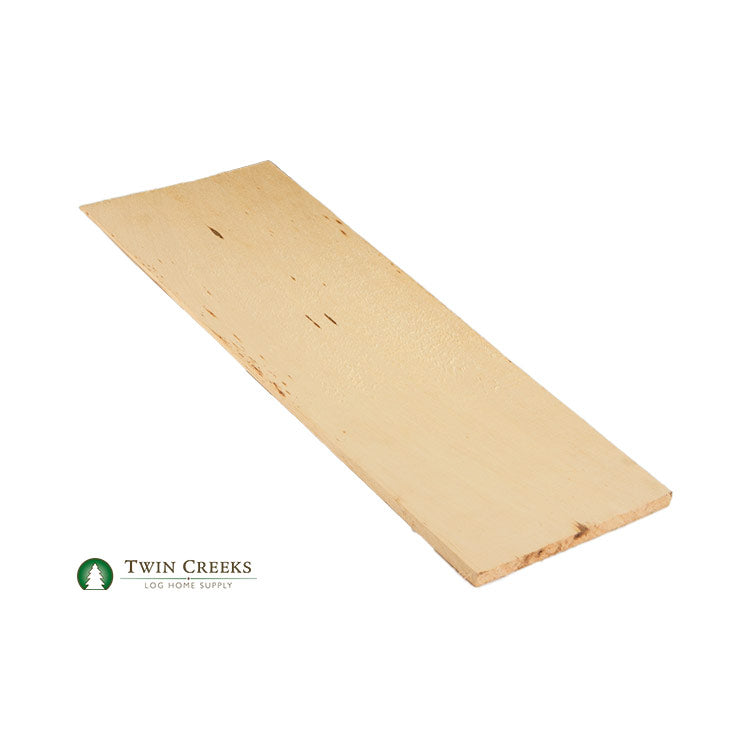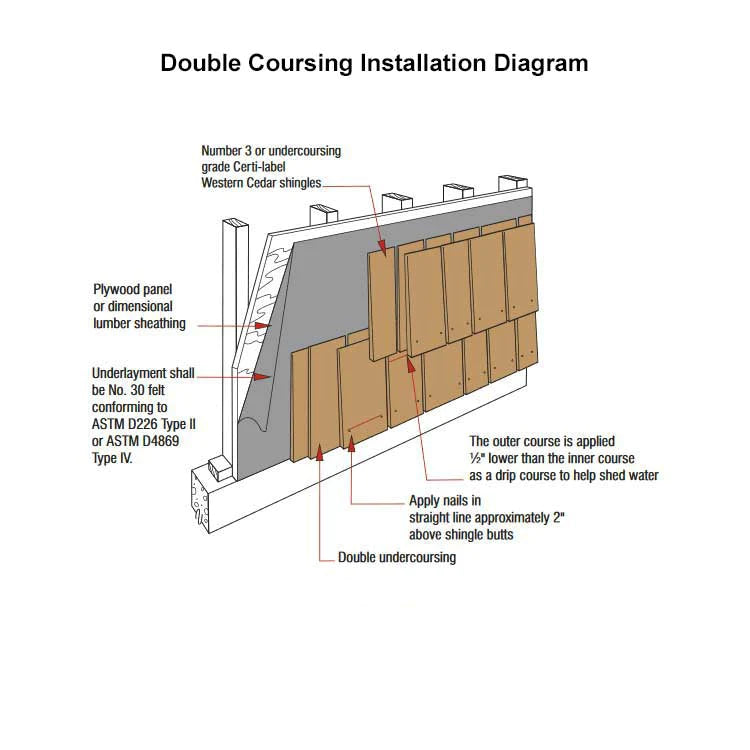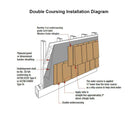Bundle #1 Grade 18" Alaskan Yellow Cedar Shingles
Bundle #1 Grade 18” Alaskan Yellow Cedar Shingles Is popular due to its unique properties and appearance. Graded to the same exacting quality control products written by the Cedar Shake and Shingle Bureau for Western Red Cedar. These products weather to a lighter, more silvery gray than Western Red Cedar.
Please call for a custom shipping quote if you need 10 or more bundles.Bundle #1 Grade 18” Alaskan Yellow Cedar Shingles Is popular due to its unique properties and appearance. Graded to the same exacting quality control products written by the Cedar Shake and Shingle Bureau for Western Red Cedar. These products weather to a lighter, more silvery gray than Western Red Cedar.
Features & Benefits of Yellow Cedar Shingles:
• Extreme Durability – Cedar Shingles easily withstand harsh weather conditions including heavy wind, rain, and hail.
• Longevity – Alaskan Yellow Cedar is known as one of the most durable softwoods. With proper maintenance Cedar Shingles can beautify your home for decades. Lasting longer than other other wood types.
• Energy Efficiency – Cedar offers excellent insulation for your home, keeping it warmer during cold months, while allowing your home to breathe and stay cooler during the warmer months.
• Termite Resistance – Alaskan Yellow Cedar wood is naturally resistant to termites.
• Ease of Installation – Great for Do-It-Yourself projects, Cedar Shingles are easy to install.
• Versatility – Alaskan Yellow Cedar Shingles can be used with many different architectural styles, affording you the option of a home covered in beautiful Cedar wood, or simply a small rustic accent area on an otherwise traditional home.
• Quality Milling – We sell only the highest quality Cedar products.
• Adaptability – Cedar Shingles are manufactured to be used on both interior and exterior wall surfaces.
Product Specifications:
• Packaging: Roofing-style bundle secured with a plastic strap. These bundles are packed 18/18. That is, 18 rows of shingles by 18 rows of shingles with the tapered tops interleaving in the middle of the pack and the butt ends facing out.
• Shingle Length: 18" (Perfection)
• Grade: Number 1 Grade. For exterior or interior walls where a superior quality product is desired. Clear heartwood: 100% edge grain; no defects.
• Texture: Natural Sawn
• Thickness: 5/2-1/4" (5 shingle “butts” stacked together should measure 2 ¼” thick)
• Width: Shingles can vary from 4”-8” wide.
• Exposure Options: These shingles can be installed with exposures from 4” to 14”.
• Typical Bundle Dimensions: 24"x18"x8"
• Shipping Options: These bundles can be shipped via UPS or FedEx within a cardboard box or can be palletized if shipped by a trucking method.
Coverage Rate Information:
• Each bundle is sized to cover 25 square feet of wall if applied at a 5-1/2" shingle exposure. The chart above provides a conversion for coverage at different exposures.
• When using double coursing, this product has a maximum recommended exposure of 14".
• When using single coursing, this product has a maximum recommended exposure of 8".
Single Coursing Vs. Double Coursing Application Methods:
• Using the single coursing application method, the shingles are installed with one layer of shingles per run.
• Using the double coursing method, two shingles are installed on top of each other on every layer. This method allows more of the face of each shingle to be exposed, providing more square footage of coverage from each bundle of shingles. Double exposure application also saves money on material and produces a more noticeable shadow line.
Estimating Cedar Shingles:
1. Start by measuring the amount of square footage you have to cover.
2. Each bundle will vary in the amount of completed coverage it will yield based on the width of exposure you choose. Exposure is the height in inches of the shingle face not covered by the next shingle course. Generally, the wider the exposure, the more coverage you will get from the bundle.
3. Using the chart above, identify the amount of coverage per bundle at your desired exposure.
4. Divide the square footage of coverage needed by the square footage per bundle value that you just selected from the chart.
Example: 500 square feet of wall needs to be covered using #1 Grade 18" (Perfection) Cedar Sidewall Shingles. The highest level of exposure is desired; therefore, the shingles can be installed as a double course with a 14" exposure. At 14" exposure, each bundle of shingles should yield 64 square feet of coverage. So, divide the 500 square feet of wall coverage by the 64 square feet of coverage per bundle (500 / 64 = 7.8 bundles). Since the calculation indicates that a partial bundle is required, round up to 8 bundles to ensure that enough shingles will be available to complete the job.
Product Resources:
Alaskan Yellow Cedar Product Selection Guide
Cedar Shake and Shingle Specification Guide
CSSB Exterior and Interior Wall Manual
CSSB New Roof Construction Manual
|
Additional Resources for 18” Alaskan Yellow Cedar Shingles: Application Notes: Single Coursing Alaskan Yellow Cedar Shingle Installation: Finishing Cedar Shingles: Nails: Staples: |
DETAILS
Bundle #1 Grade 18” Alaskan Yellow Cedar Shingles Is popular due to its unique properties and appearance. Graded to the same exacting quality control products written by the Cedar Shake and Shingle Bureau for Western Red Cedar. These products weather to a lighter, more silvery gray than Western Red Cedar.
Features & Benefits of Yellow Cedar Shingles:
• Extreme Durability – Cedar Shingles easily withstand harsh weather conditions including heavy wind, rain, and hail.
• Longevity – Alaskan Yellow Cedar is known as one of the most durable softwoods. With proper maintenance Cedar Shingles can beautify your home for decades. Lasting longer than other other wood types.
• Energy Efficiency – Cedar offers excellent insulation for your home, keeping it warmer during cold months, while allowing your home to breathe and stay cooler during the warmer months.
• Termite Resistance – Alaskan Yellow Cedar wood is naturally resistant to termites.
• Ease of Installation – Great for Do-It-Yourself projects, Cedar Shingles are easy to install.
• Versatility – Alaskan Yellow Cedar Shingles can be used with many different architectural styles, affording you the option of a home covered in beautiful Cedar wood, or simply a small rustic accent area on an otherwise traditional home.
• Quality Milling – We sell only the highest quality Cedar products.
• Adaptability – Cedar Shingles are manufactured to be used on both interior and exterior wall surfaces.
Product Specifications:
• Packaging: Roofing-style bundle secured with a plastic strap. These bundles are packed 18/18. That is, 18 rows of shingles by 18 rows of shingles with the tapered tops interleaving in the middle of the pack and the butt ends facing out.
• Shingle Length: 18" (Perfection)
• Grade: Number 1 Grade. For exterior or interior walls where a superior quality product is desired. Clear heartwood: 100% edge grain; no defects.
• Texture: Natural Sawn
• Thickness: 5/2-1/4" (5 shingle “butts” stacked together should measure 2 ¼” thick)
• Width: Shingles can vary from 4”-8” wide.
• Exposure Options: These shingles can be installed with exposures from 4” to 14”.
• Typical Bundle Dimensions: 24"x18"x8"
• Shipping Options: These bundles can be shipped via UPS or FedEx within a cardboard box or can be palletized if shipped by a trucking method.
Coverage Rate Information:
• Each bundle is sized to cover 25 square feet of wall if applied at a 5-1/2" shingle exposure. The chart above provides a conversion for coverage at different exposures.
• When using double coursing, this product has a maximum recommended exposure of 14".
• When using single coursing, this product has a maximum recommended exposure of 8".
Single Coursing Vs. Double Coursing Application Methods:
• Using the single coursing application method, the shingles are installed with one layer of shingles per run.
• Using the double coursing method, two shingles are installed on top of each other on every layer. This method allows more of the face of each shingle to be exposed, providing more square footage of coverage from each bundle of shingles. Double exposure application also saves money on material and produces a more noticeable shadow line.
Estimating Cedar Shingles:
1. Start by measuring the amount of square footage you have to cover.
2. Each bundle will vary in the amount of completed coverage it will yield based on the width of exposure you choose. Exposure is the height in inches of the shingle face not covered by the next shingle course. Generally, the wider the exposure, the more coverage you will get from the bundle.
3. Using the chart above, identify the amount of coverage per bundle at your desired exposure.
4. Divide the square footage of coverage needed by the square footage per bundle value that you just selected from the chart.
Example: 500 square feet of wall needs to be covered using #1 Grade 18" (Perfection) Cedar Sidewall Shingles. The highest level of exposure is desired; therefore, the shingles can be installed as a double course with a 14" exposure. At 14" exposure, each bundle of shingles should yield 64 square feet of coverage. So, divide the 500 square feet of wall coverage by the 64 square feet of coverage per bundle (500 / 64 = 7.8 bundles). Since the calculation indicates that a partial bundle is required, round up to 8 bundles to ensure that enough shingles will be available to complete the job.
Product Resources:
Alaskan Yellow Cedar Product Selection Guide
Cedar Shake and Shingle Specification Guide
CSSB Exterior and Interior Wall Manual
CSSB New Roof Construction Manual
MORE INFORMATION
|
Additional Resources for 18” Alaskan Yellow Cedar Shingles: Application Notes: Single Coursing Alaskan Yellow Cedar Shingle Installation: Finishing Cedar Shingles: Nails: Staples: |














